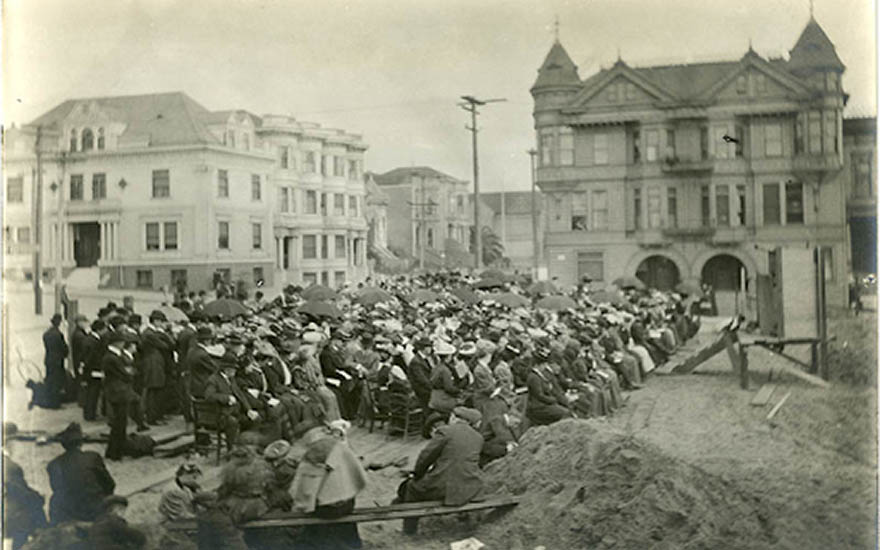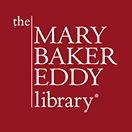How have Christian Scientists responded to natural disasters?

First Christian Science service after the earthquake and fires, San Francisco, Sunday, April 29, 1906. P07543. Unknown photographer.
(Updated December 2021)
Our hearts go out to people affected by the recent tornado outbreak in the United States. In destructive events like these, the most important thing is to keep people and their communities safe. At the same time, reports of bravery, resourcefulness, fortitude, and compassion in the face of danger are so encouraging.
We wondered what our archives could tell us about how Christian Scientists have responded to disasters over the years.The record is extensive!
We found that The Christian Science Monitor has reported consistently on such events since Mary Baker Eddy founded it in 1908. While providing coverage on the ground, the Monitor has also tended to report on underlying causes and possible solutions. One recent editorial, “After a megafire, what Paradise found,” illustrated this. “Drawing the right lessons from a disaster is not always easy,” it observed. “The default is to look for something or someone to blame—climate change, zoning laws, or sparks from an electric utility’s equipment. Fixing such issues is critical, but just as critical are shifts in thought, such as learning to be calm as the flames approach and being alert to the needs of neighbors.”1
We noted many instances of calm—and common sense—as well as deep care for others in the life of Eddy and the history of the movement she founded. She was alert to disasters and to the suffering they caused, as well as to the theological assumptions associated with them. And she saw the possibility that “shifts in thought” could play a constructive and reconstructive role. Eddy did not think that God sent disaster as punishment or allowed it as part of the divine purpose. For example, on June 5, 1887, she preached a sermon titled “Spirit and Law” that touched on these claims. Notes on that sermon were published in The Christian Science Journal the following month. Later it appeared in her Miscellaneous Writings 1883-1896.2
Eddy had been a resident of Lynn, Massachusetts, when the great fire of November 9–10, 1872, devastated central Boston, just ten miles away. Over a decade later Susan H. Hall, one of her correspondents, remembered “the dreadful Boston fire” as she catalogued her family’s woes.3 But it also pushed forward fire safety measures. The 1892 Deed of Trust, which conveyed land in Boston from Eddy to the Christian Science Board of Directors—on which to build a church—noted, “If said building is burned, the Directors shall forthwith proceed to rebuild the church.”4 And when the Original Mother Church was dedicated in early 1895, four of the newspaper stories reprinted in the book Pulpit and Press, which chronicled its construction and dedication, approvingly reported that the church was as “fire-proof” as possible.5
Large-scale calamities formed part of a backdrop that turned some people to the healing message of Christian Science. In her book Science and Health with Key to the Scriptures, Eddy addressed the spiritual problem that disaster posed to people’s faith in God. See, for example, passages such as one beginning on page 119, next to the marginal note “Unescapable dilemma.”6
While critics claimed that Christian Scientists ignored evil and disaster, the actions of Eddy and her followers often belied those claims. We found evidence of this in her published writings and correspondence, in biographies, in the organizational records of The Mother Church (The First Church of Christ, Scientist), and in the church’s magazines.
Eddy herself contributed to funds aiding those affected by earthquakes, fires, and war. Christian Scientists were active on this front, as well.
By many counts the hurricane that struck Galveston, Texas, on September 8, 1900, still ranks as the greatest natural disaster ever to have hit the US. When First Church of Christ, Scientist, Galveston, met for its first testimony meeting after that storm, members gave gratitude for the prayer that had brought them immediate evidence of help and protection.7 Their church edifice survived the 140 mile-per-hour winds, and the congregation was able to hold services the following week, in addition to offering use of their building “to any denomination whose church was so damaged by the storm as to be unfit for service.”8 The church also voted on a resolution of thanks “for the many loving messages, tender inquiries for the safety of its members, and the substantial assistance received from the dear Christian Scientists and Christian Science Churches….”9
The 1906 San Francisco, California, earthquake, along with the fires that followed it, devastated that growing city. We learned how Christian Scientists inside and outside the Bay Area took part in relief and rebuilding. You can read about it here. Members from all walks of life, including Frank W. Gale and Sue Ella Bradshaw, two pioneer practitioners and teachers of Christian Science, played vital roles.
Disaster response in the early twentieth-century Christian Science movement occasionally took the form of designating the Sunday offering, or collection, of The Mother Church, for aid groups. The Mother Church sent its Sunday collections from September 9, 1923, to support relief work for people of all faiths after a damaging Japanese earthquake shook Tokyo and Yokohama on September 1. Through a notice in the Christian Science Sentinel, the Board of Directors invited branch churches and individuals to send in donations for relief work in Japan.10 Following the record-breaking Tri-State Tornado of March 18, 1925, which devastated portions of Missouri, Illinois, and Indiana, The Mother Church again utilized its Sunday collections to support relief work. This was in addition to $40,000 (equal to $615,000 in 2021) already donated by the church.11 More often, and in the years since, The Mother Church has quietly donated funds for disaster relief. The Library’s archives contain letters of thanks from the Red Cross and other humanitarian agencies.
The most extensive firsthand accounts of Christian Scientists’ encounters with disasters are found in the articles and testimonies of the Christian Science magazines. One high-profile account came from Lieutenant C. H. Lightoller, R.N.R., who survived the sinking of the SS Titanic in 1912. You can read it here.
Many other accounts have told of writers’ experiences in less well-known but equally challenging situations. For example in 1951 Eunice Moulton of Los Angeles, California, told how she came upon a wildfire threatening a friend’s farm. “Someone said, ‘This is too big for us,’” she wrote. “I immediately declared, ‘It is not bigger than God.’”12 Some testifiers mentioned protection from harm in longer accounts of healing.13 In 1977 a Girl Scout wrote about how she prayed when the summer camp she was attending was evacuated under threat of fire.14 Others told of simple ideas that came through prayer and helped them face crises such as the loss of homes, loved ones, and livelihoods because of sudden calamities.
The Christian Science magazines publish articles on a variety of subjects, usually emphasizing how to apply the teachings of the Bible and Eddy’s writings to all kinds of problems. Pieces on protection from danger have appeared consistently. One is “Safety,” by Blanche Hersey Hogue, a Christian Science practitioner and teacher from Portland, Oregon. It was published in the December 1937 Journal. It’s of particular interest because it includes an instance of applying the religion’s teachings during a fire event. Read and listen to the article here.
Other articles and testimonies treating disasters and related subjects can be found by searching the JSH-Online website, using key words such as danger, fire, forest fire, disaster, protection, safe, and security. These offer a glimpse into the ways Christian Scientists have been affected by, and dealt with, disasters throughout the history of their movement.
This article is also available on our French, German, Portuguese, and Spanish websites.
- “After a megafire, what Paradise found,” The Christian Science Monitor, 11 September 2020, https://www.csmonitor.com/Daily/2020/20200911?cmpid=ema:ddp:20200911:1114116:read&sfmc_sub=13813265&id=1114116#1114116
- Mary Baker Eddy, Miscellaneous Writings 1883–1896 (Boston: The Christian Science Board of Directors), 256–259.
- Susan H. Hall to Eddy, 12 December 1884, 674b.74.023.
- Eddy, Manual of The Mother Church (Boston: The Christian Science Board of Directors), 132.
- Eddy, Pulpit and Press (Boston: The Christian Science Board of Directors), 25, 57, 70, 75.
- Eddy, Science and Health with Key to the Scriptures (Boston: The Christian Science Board of Directors), 119.
- ”Wednesday Evening Meeting at Galveston, Tex.,” Christian Science Sentinel, 1 November 1900.
- ”Among the Churches,” Sentinel, 20 September 1900.
- “Among the Churches,” Sentinel, 8 November 1900.
- The Christian Science Board of Directors, “Announcement,” Christian Science Sentinel, 22 September 1923, 70.
- Board of Directors, “Contributions,” Sentinel, 4 April 1925, 610; “Collections and Tornado Relief,” Monitor, 23 March 1925, 1; “Relief Calls from Tornado Area Answered,” Monitor, 19 March 1925, 1.
- Testimony, Eunice Moulton, Sentinel, 24 November 1951.
- See, for example, the testimony of Persis E. Zuber, The Christian Science Journal, December 1967.
- Testimony, Julie Miles with Pamela Ludlam Miles, Sentinel, 12 March 1977.

